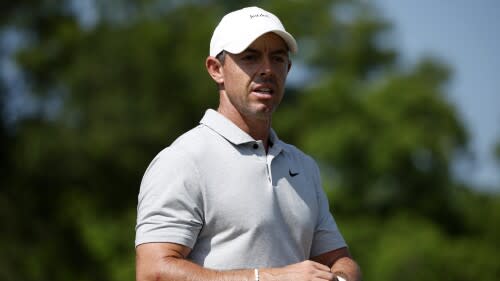Cut Line: What we know - and want to know - about the Player Equity Program

In this week’s edition, we dissect the secretive rollout of the PGA Tour’s Player Equity Program, Rory McIlroy’s possible return to the policy board and the divide in golf that might not be as vast as it currently looks.
Made Cut
Variety. When the Zurich Classic moved to a two-man team event, it wasn’t clear how something so different would fit into the Tour schedule. But now in its seventh year, the tournament has become a breath of fresh air in a lineup dominated by individual stroke-play events.
The team element has allowed for creative pairings and a level of intrigue that the event, which is wedged squarely between the Masters and PGA Championship, likely wouldn’t enjoy if it didn’t have the likes of Rory McIlroy and Shane Lowry, who are on pace to represent Ireland at this year’s Olympics and were in contention Friday at TPC Louisiana.
“It's a tournament that I've watched on TV for quite a few years, especially since they went to the team format. Shane and I have played in a couple of Ryder Cup teams together and we thought it would be fun to team up together again in something like this,” McIlroy said.
It's probably not the best time to be recommending new tournament formats given the rhetoric between the Tour and LIV Golf, but the Zurich Classic is a standalone success that could use some company.
Nuance. While the Tour continues to wrestle with a potential deal with Saudi Arabia’s Public Investment Fund and a potential reunification of the professional game, there remains doubt the circuit will be able to pull off such a polarizing coup, particularly any plan that would allow players who joined LIV Golf to return to the Tour’s ecosystem.
Finding a consensus on how players like Jon Rahm or Brooks Koepka might be welcomed back, either with or without potential fines and suspensions, is proving to be exceedingly difficult. But, on this front, the DP World Tour has already created a pathway.
Guy Kinnings, the newly appointed chief executive of the European tour, was asked this week in an interview with GolfDigest.com how players, like Rahm, might be allowed to play for Europe at next year’s Ryder Cup.
“The reality is that, under the current system, if a player is European and is a member of the DP World Tour and abides by the rules in place, he is eligible,” Kinnings said.
Kinnings went on to explain that the European circuit’s rules allow for suspensions and fines for players who violate its conflicting-event release polices by playing LIV events, but as long as those players pay those fines and serve those suspensions they maintain their eligibility and the chance to either qualify or be picked for next year’s Ryder Cup team.
There are no easy solutions to the professional game’s complicated predicament but, as the European tour has proven, there are nuanced answers.
Rory McIlroy says he’d rejoin PGA Tour policy board, ‘if people want me involved’
McIlroy said on Wednesday in New Orleans that he’d be willing to resume his previous role.
Made Cut-Did Not Finish (MDF)
Politics. Aside from the palace intrigue, McIlroy’s imminent return to the PGA Tour’s policy board, as well as the newly formed board of directors for the circuit’s for-profit arm, created plenty of talking points this week.
McIlroy touched on the most obvious element of his potential return when asked why he’d consider going back on the board after resigning his position as a player director last November.
“I think I can be helpful,” he said this week when asked, hypothetically, why he’d want back in the board room. “I don't think there's been much progress made in the last eight months and I was hopeful that there would be. I think I could be helpful to the process.”
McIlroy has become an outspoken proponent of reunification of the game and a deal between the Tour and PIF, and if his voice and vote move that along more quickly, then all the better.
Some, however, see the move as McIlroy and the Tour circumventing the system. Normally, a member of the Player Advisory Council is voted to be chairman of the PAC for one year before ascending to the policy board by a vote of the entire Tour membership.
Because Webb Simpson, who reportedly asked if McIlroy could take his spot on the board, has another year remaining as a player director, the vote instead goes to the remaining board members.
“How in the world can he resign from the board and then come back to rejoin the board without being reelected weeks later?” asked one Tour player.
McIlroy is probably the right person for the job given the landscape, but the politics of it all doesn’t feel great.
PGA Tour lays out how the Player Equity Program will work
The Tour let players know on Wednesday what their individual grants would be.
Compensation. The Tour rolled out its long-awaited Player Equity Program this week with literally no fanfare.
The program is set to award approximately $930 million to 193 different players in initial equity, which was announced in February, with the only new information being the total vesting period before players can cash in on those grants (eight years) and how, roughly, the grants were awarded via a “career points” list and other benchmarks.
The equity grants are part of a larger compensation plan the Tour has created to stem the flow of top players going to LIV Golf and reward that loyalty. It also gives players ownership of the Tour, which is unique in major American sports, and a reason to be dedicated to the best possible product, which will likely include much more than simply their play on the course.
Missed Cut
Transparency. The Tour has never been the most forthcoming of organizations and there were plenty of reasons to control much of the player-equity message, but there are questions that neither violate private financial requirements or the circuit’s own concern for confidentiality.
For example, of the four groups of players who received their initial equity letters from the commissioner this week, it’s the fourth category, dubbed “past legends,” that produced the most questions.
While most agree that Jack Nicklaus should be first on that list, which will include 36 players and $75 million in equity, it’s unclear what the remainder of that list would look like. Assuming Tiger Woods would be among the Group 1 recipients for equity (a player can only qualify for one group), what would the “career points” list – which awards points based on how long a player was a Tour member, events won and how many times they reached the Tour Championship – look like for a “legend?”
Many of the “past legends” didn’t play in the FedExCup era and likely didn’t value a trip to the season finale like players do now. There’s also the question of how a “legend” becomes vested since most players in this category are well beyond their playing days even on the PGA Tour Champions.
It's clear the Tour is more interested in confidentiality, but that only creates more questions.



